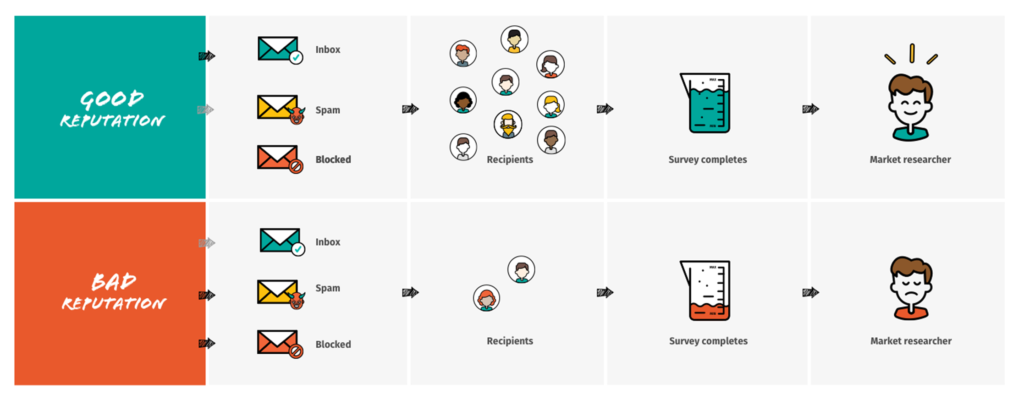The relationship between reputation and business success is a well-known fact. While a good reputation improves sales performance and increases a brand’s value, a bad reputation can rapidly take a business downhill. Aware of this, many companies pay meticulous attention to detail when it comes to product quality and customer service. Yet they often overlook the need to also maintain a good email reputation, which directly impacts the ability to communicate online.
What is email reputation
Email reputation is a technical metric which email service providers use to decide the ‘credibility’ of sent messages. It is defined by a score relating to the sender domain (i.e. the “nipo.com” part of an email address).
This score, which can continually change, determines whether messages get delivered into recipients’ inboxes, spam folders or are even delivered at all. You can think of it a bit like a personal credit rating, which banks use to decide whether they should lend you money.
Why email reputation matters to market researchers
There’s no point in sending out a survey invitation if it won’t arrive in recipients’ inboxes. If your sender domain has a bad reputation, your message is likely to be swallowed into people’s spam folders or, worse still, be blocked from being delivered at all.
But if care has been taken to adopt good practices which result in a good email reputation, your survey invitations are much more likely to arrive in a place they’ll be seen, reaching recipients’ inboxes directly and without delay.
The sender domain’s email reputation can therefore make or break the success of your market research project.

Why the email reputation system was created
The ease and cost-effectiveness of using email to communicate with consumers and companies alike has led to staggering amounts of email traffic. There are currently 3 billion email users worldwide, and rising – approximately 50% of the planet’s population.
Unfortunately, this simplicity and accessibility has given rise to spamming and dishonest emailing practices, by which irrelevant or unsolicited emails are sent, typically to a large number of recipients, for the purposes of advertising, phishing, and distributing malware. This has turned into a big business, with various reports estimating that spam messages account for 50 – 80% of the world’s email traffic.
Email service providers needed to do something to protect email recipientsfrom the influx of unwanted and dangerous emails, which has resulted in the email reputation system currently in use.
Most of the world’s email traffic is spam. Email reputation is intended to help legitimate messages, like your survey invitations, take priority.
How email reputation works
Email reputation is the total result of combining a number of quantitative metrics designed to evaluate how honest and well-targeted emails from a particular domain are. The total score a domain accrues determines whether its outgoing messages are blocked, directed to spam folders or successfully delivered to inboxes.
Whatever role you work in, it’s worth understanding the two most fundamental aspects of email reputation:
- Email reputation measurement is primarily based on the sending domain (e.g. “nipo.com”) rather than individual email addresses (e.g. “person@nipo.com”). But there are no universal rules for achieving a good reputation because each email service provider (Google, Outlook, etc…) applies different, publicly unknown algorithms. This means that what works for one email provider won’t necessarily work for other email providers.
- An email reputation score is derived over a domain’s entire lifetime. It starts being calculated from the very first email sent from that domain, and continues to be adjusted with every email that goes out. The reputation can improve and decline over time, but the score can never be completely reset to start all over again. A domain which has earned itself a very bad reputation, at any point, will have to live with the consequences forever.
And this is one of the most difficult things with email reputation: it can take a long time to earn a good reputation, but it is possible to destroy it in an instant. Vigilance in responsible email practices needs to be applied at all times.
If you want impressive response rates, look after your email reputation!
Aspects which influence email reputation score
Events and aspects which are widely understood to damage email reputation include:
Recipients marking email as spam – The more times your emails are marked by recipients as spam, the more likely email service providers are to conclude that you’re sending unsolicited messages.
Poor email engagement – Email providers are interested in how relevant your messages are to their recipients, and they judge this by what percentage of the mails get opened. A low open rate is considered to mean recipients aren’t interested in them.
Invalid recipient addresses – Sending messages to invalid email addresses is fatal for your email reputation. It’s a clear sign that you don’t actually know who you are sending your messages to.
Type of email content – Email providers have become very skilled in identifying certain keywords and phrases which are likely to indicate an email as being unsolicited or dangerous. All messages are scanned for these.
Unverified sending domain – Dangerous senders often try to pretend to be someone they are not by using someone else’s domain. Many email service providers therefore block emails coming from an unverified sender domain.
Irregular frequency and volumeof emails – Because spammers don’t tend to have a consistent send frequency, email providers look at how often your messages are sent out. Changing the frequency may damage your email reputation.
Lack of history – If there is no history, email providers cannot draw any conclusions about your intentions. Remember that you start enhancing or damaging your email reputation from the first send-out.
How to build and maintain a good email reputation
The good news is that you can always have control over your email reputation.
To find out how, check out our practical guide on building a good reputation and ensuring smooth delivery of all your survey invitations sent out by Nfield Online.
Learn how to build a good email reputation and deliver more survey invitations.

